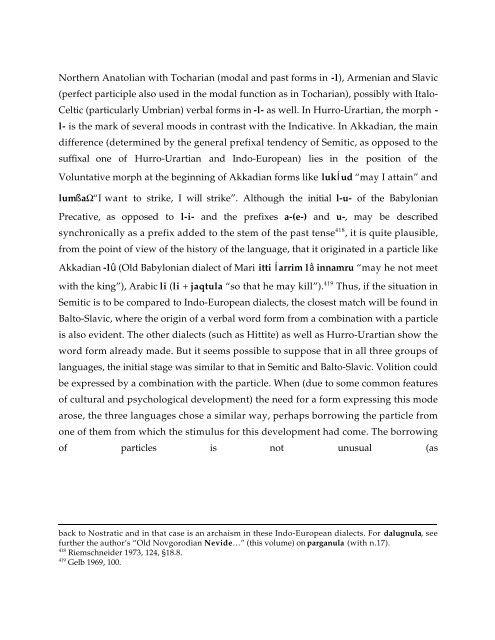Comparative Notes on Hurro-Urartian, Northern Caucasian
Comparative Notes on Hurro-Urartian, Northern Caucasian
Comparative Notes on Hurro-Urartian, Northern Caucasian
Create successful ePaper yourself
Turn your PDF publications into a flip-book with our unique Google optimized e-Paper software.
<strong>Northern</strong> Anatolian with Tocharian (modal and past forms in -l), Armenian and Slavic<br />
(perfect participle also used in the modal functi<strong>on</strong> as in Tocharian), possibly with Italo-<br />
Celtic (particularly Umbrian) verbal forms in -l- as well. In <strong>Hurro</strong>-<strong>Urartian</strong>, the morph -<br />
l- is the mark of several moods in c<strong>on</strong>trast with the Indicative. In Akkadian, the main<br />
difference (determined by the general prefixal tendency of Semitic, as opposed to the<br />
suffixal <strong>on</strong>e of <strong>Hurro</strong>-<strong>Urartian</strong> and Indo-European) lies in the positi<strong>on</strong> of the<br />
Voluntative morph at the beginning of Akkadian forms like lukÍud “may I attain” and<br />
lumßaΩ “I want to strike, I will strike”. Although the initial l-u- of the Babyl<strong>on</strong>ian<br />
Precative, as opposed to l-i- and the prefixes a-(e-) and u-, may be described<br />
synchr<strong>on</strong>ically as a prefix added to the stem of the past tense 418 , it is quite plausible,<br />
from the point of view of the history of the language, that it originated in a particle like<br />
Akkadian -lû (Old Babyl<strong>on</strong>ian dialect of Mari itti Íarrim lâ innamru “may he not meet<br />
with the king”), Arabic li (li + jaqtula “so that he may kill”). 419 Thus, if the situati<strong>on</strong> in<br />
Semitic is to be compared to Indo-European dialects, the closest match will be found in<br />
Balto-Slavic, where the origin of a verbal word form from a combinati<strong>on</strong> with a particle<br />
is also evident. The other dialects (such as Hittite) as well as <strong>Hurro</strong>-<strong>Urartian</strong> show the<br />
word form already made. But it seems possible to suppose that in all three groups of<br />
languages, the initial stage was similar to that in Semitic and Balto-Slavic. Voliti<strong>on</strong> could<br />
be expressed by a combinati<strong>on</strong> with the particle. When (due to some comm<strong>on</strong> features<br />
of cultural and psychological development) the need for a form expressing this mode<br />
arose, the three languages chose a similar way, perhaps borrowing the particle from<br />
<strong>on</strong>e of them from which the stimulus for this development had come. The borrowing<br />
of particles is not unusual (as<br />
back to Nostratic and in that case is an archaism in these Indo-European dialects. For dalugnula, see<br />
further the author’s “Old Novgorodian Nevide…” (this volume) <strong>on</strong> parganula (with n.17).<br />
418 Riemschneider 1973, 124, §18.8.<br />
419 Gelb 1969, 100.





